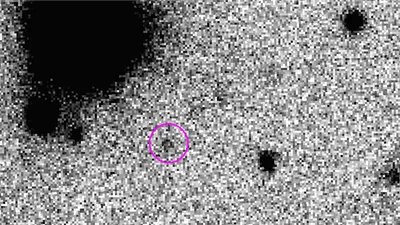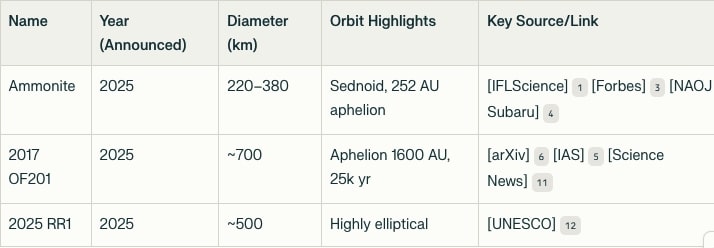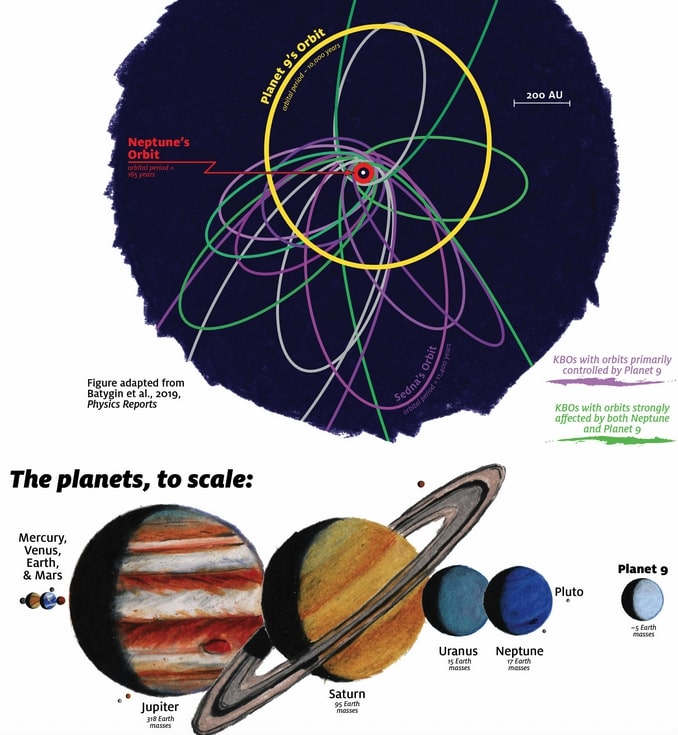Now Reading: New Dwarf Planets Beyond Neptune in 2025
-
01
New Dwarf Planets Beyond Neptune in 2025
New Dwarf Planets Beyond Neptune in 2025

Ammonite was discovered using the Subaru Telescope in Hawaii, with follow-up confirmation from the Canada-France-Hawaii Telescope. Its orbit and size officially qualify it as a distant dwarf planet.
Estimated diameter: 220–380 km
Perihelion (closest approach to the Sun): 50–75 AU (1 AU = Earth–Sun distance)
Aphelion: ~252 AU
Orbit is highly stable and very distant from Neptune, indicating ancient origins.
Ammonite’s orbit differs from other known sednoids, suggesting a unique dynamical history in the outer solar system. Its existence challenges the Planet Nine hypothesis, as its orbit does not align with the clustering that would be expected from an unseen massive planet. Instead, it may indicate that the early solar system experienced dramatic, possibly star-driven, shaping events.
Dwarf Planets as of Wed Apr 9 2025 there are:
10 objects which are nearly certainly dwarf planets,
27 objects which are highly likely to be dwarf planets,
68 objects which are likely to be dwarf planets,
130 objects which are probably dwarf planets, and
741 objects which are possibly dwarf planets.
In 2025, two notable dwarf planet candidates have been discovered or formally announced in our solar system, both trans-Neptunian objects (TNOs) located far beyond Neptune. These are 2017 OF201, announced in May and 2023 KQ14 (nicknamed “Ammonite”), announced in July.
2017OF201 was found using data from the Dark Energy Camera Legacy Survey (DECaLS) and the Canada-France-Hawaii Telescope (CFHT), spanning 19 observations over seven years from 2011 to 2018. The object is currently at 90.5 au from the Sun, with a semi-major axis of 838 au, a perihelion of 44.9 au, an aphelion of about 1632 au, and an orbital period of roughly 24,256 years. Its estimated diameter is around 700 km (assuming an albedo of 0.15), making it the second-largest known object in this dynamical class after Sedna.

Pluto was demoted as a planet because Astronomers anticipated finding about 10,000 Pluto-like objects. Astronomer Mike Brown considers 130 trans-Neptunian bodies to be likely dwarf planets, ranked them by estimated size. He does not consider asteroids, stating “in the asteroid belt Ceres, with a diameter of 900 km, is the only object large enough to be round.
Vera Rubin Telescope And Other New Scopes
Within its first few nights of observing, Rubin discovered nine new trans-Neptunian objects (TNOs), the class that includes many dwarf planets, suggesting hundreds or thousands could follow.
Current discovery rates for TNOs (including dwarf planet candidates) are low—about 100-200 new TNOs per year from all telescopes combined, with only 1-2 dwarf planet candidates announced annually (e.g., 2017 OF201 and 2023 KQ14 “Ammonite” in 2025). LSST is projected to multiply this by orders of magnitude for TNOs overall, leading to a surge in dwarf planet candidates. In its first year alone, LSST could reveal more solar system objects than have been discovered in the past 150 years combined, with rapid follow-up built into the survey due to repeated observations (typically 200-500 per object over 10 years). This will accelerate both initial detections and orbital confirmations, potentially shortening the time from discovery to candidate status from years to months.
Specific projections for confirmed dwarf planets are uncertain because confirmation requires detailed characterization (e.g., size, shape, and equilibrium state), but estimates for candidates are based on population models and LSST’s yield:LSST is expected to discover approximately 40,000 new TNOs and scattered disk objects (SDOs) over its 10-year survey, a ~10x increase over the current ~4,000 known TNOs.
Among these, models suggest dozens of objects large enough (>500-1,000 km diameter) to be dwarf planet candidates, based on size-frequency distributions. For example, brighter objects (absolute magnitude H 5-6, comparable to known dwarf planets like Eris or Haumea) could yield 10-50 new candidates, with a discovery rate of ~5-10 per year once the survey ramps up (peaking in years 2-5 as fainter objects are detected). This includes potential “Sednoids” or extreme TNOs beyond 100 au, where a handful of Pluto-sized or larger bodies might be found.
Other telescopes like JWST or the Nancy Grace Roman Space Telescope (launching ~2027) are not optimized for wide-field discovery but will indirectly boost rates by confirming LSST candidates through targeted observations, potentially adding 2-5 confirmations per year for edge cases.
* Over the next decade, Rubin’s data is expected to nearly quadruple the number of cataloged small bodies, and “continue to discover hundreds of new comets, the remaining few dwarf planets, and maybe even a new planet in our solar system.”
* The expected detection rate for major outer solar system bodies (including dwarf planets) is likely to be several per year at minimum, especially as Rubin surveys faint, slow-moving objects in the Kuiper Belt and beyond.
How Will Rubin Achieve This?
* Largest digital camera in the world (3,200 megapixels) and a huge field of view
* Rapid, repeated coverage of the sky: This allows for detection of slow-moving objects hundreds of times fainter than prior surveys
* Advanced discovery algorithms: Rubin’s software reviews billions of detections nightly, identifying new small bodies by tracking their subtle movements over days, weeks, and years.
* Unprecedented depth and sensitivity: Reaches much fainter magnitudes than prior all-sky surveys, essential for finding distant, dim dwarf planets in the Kuiper Belt and beyond
Expected Brown Dwarf Star DiscoveriesB
While LSST is projected to discover thousands of brown dwarfs stars. Objects that are 13-80 times the mass of Jupiter and are often free-floating or orbiting star. These are entirely different from dwarf planets. Brown dwarfs are detected via their faint infrared glow and proper motion in stellar fields, not as moving solar system objects. Estimates suggest LSST could identify 10,000-100,000 new brown dwarfs over 10 years (including ultra-cool Y-dwarfs).

Brian Wang is a Futurist Thought Leader and a popular Science blogger with 1 million readers per month. His blog Nextbigfuture.com is ranked #1 Science News Blog. It covers many disruptive technology and trends including Space, Robotics, Artificial Intelligence, Medicine, Anti-aging Biotechnology, and Nanotechnology.
Known for identifying cutting edge technologies, he is currently a Co-Founder of a startup and fundraiser for high potential early-stage companies. He is the Head of Research for Allocations for deep technology investments and an Angel Investor at Space Angels.
A frequent speaker at corporations, he has been a TEDx speaker, a Singularity University speaker and guest at numerous interviews for radio and podcasts. He is open to public speaking and advising engagements.

























